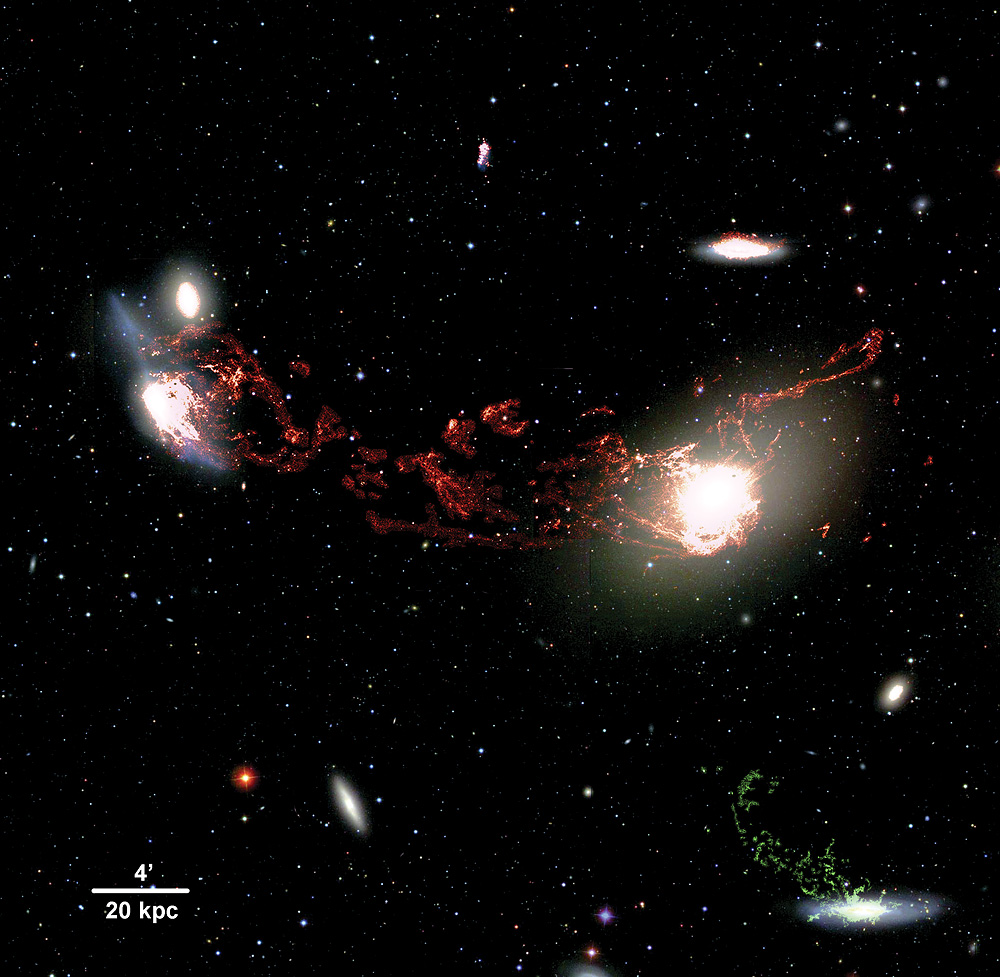[/caption]
It’s a violent universe out there! Yesterday we ran an article about galaxies colliding and forming fireballs. Today, there’s more evidence for galactic collisions, and it’s not good news for potential stars. While this image is stunning, such collisions could spell doom for future star formation. A deep new image of the Virgo cluster has revealed huge tendrils of ionized hydrogen gas 400,000 light-years long connecting the elliptical galaxy M86 and the disturbed spiral galaxy NGC 4438. This image, taken by the 4-meter telescope at Kitt Peak National Observatory, provides striking evidence of a previously unsuspected high-speed collision between the two galaxies. “Our data show that this system represents the nearest recent collision between a large elliptical galaxy and a large spiral,” said Jeffrey Kenney of Yale University, “This discovery provides some of the clearest evidence yet for high-speed collisions between large galaxies, and it suggests that the consequences of such collisions are a plausible alternative to black holes in trying to explain the mystery of what process turns off star formation in the biggest galaxies.”
Astronomers have been trying to understand the mystery of what causes the biggest galaxies in the Universe—which are primarily ellipticals, like M86—to stop forming stars. “Something needs to heat up the gas so it doesn’t cool and form stars,” Kenney says. “A number of recent studies suggest that energy from active galactic nuclei associated with supermassive black holes may do this, (see Universe Today articles here and here) but our new study shows that gravitational interactions may also do the trick.”
The Virgo cluster is located approximately 50 million light-years from Earth. Previous studies had noticed disturbed H-alpha gas around each of the two galaxies, but scientists didn’t think the two had a connection. Indeed, some results have suggested that NGC 4438 collided with the small lenticular galaxy NGC 4435, but NGC 4435 has a much higher line-of-sight velocity as seen from Earth and appears undisturbed.
Spectroscopy of selected regions along the filament between M86 and NGC 4438 shows a fairly smooth velocity gradient between the galaxies, supporting the collision scenario. And here’s the kicker: there are no obvious stars in the filaments.
As in most elliptical galaxies, most of the gas within M86 is extremely hot, and therefore radiates X-rays. The X-ray distribution in M86 is irregular and sports a long plume, which had previously been interpreted as a tail of gas which is being stripped by ram pressure as M86 falls into the intracluster medium of the Virgo cluster. The new H-alpha image from Kitt Peak suggests that most of the disturbances to the interstellar medium in M86 are instead due to the collision with NGC 4438.
Low-velocity collisions, especially between small- to medium-sized galaxies, often cause an increase in the local star formation rate, as the collisions tend to cause gas to concentrate in the galaxy centers. But in high velocity collisions (which happen naturally between large galaxies, since their large gravity pulls mass inward much faster), the kinetic energy of the collision can cause the gas to heat up so much that it cannot easily cool and form stars.
While not many galaxies suffer such extreme collisions as M86, most galaxies experience minor mergers and gas accretion events, and these may play a significant role in heating the galaxy’s gas. These more common but modest events are very hard to study, since their observational signatures are weak.
“The same physical processes occur in both strong and weak encounters, and by studying the observable effects in extreme cases like M86 we can learn about the role of gravity in the heating of galaxy gas, which appears to be quite significant,” Kenney adds.
Kenney is the lead author of a paper to be published in a November 2009 issue of Astrophysical Journal Letters.
Source: NOAO


Notice the inter-galactic junk off to the bottom right, also.
As John Mendenhall points out, the ‘intergalactic junk’ at the bottom right represents gas being tidally stripped from the galaxy NGC 4388 moving through the Virgo Cluster. The paper referencing this result (and M 86 -NGC 4438) can be found at arXiv:0810.0711 by JDP Kenney et al posted on October 3, 2008. By pure happenstance, I was reading a paper by JC Mihos et al published in the Astrophysical Journal Letters Vol. 631, L41-L43, September 20, 2005 entitled ‘Diffuse Light in the Virgo Cluster’. Although this paper examined this same region in the Virgo Cluster, the survey looked at continuum light between these galaxies & thus missed the hydrogen alpha emission seen in this current study. Still, this short paper (try googling the Journal reference, its available thru ADS or NED) does show some remarkable, coincidental similarities of this region of the Virgo Cluster. The new paper referenced above addresses both the H-alpha filaments between M 86 & NGC 4438 and the ‘green’ H-alpha emission seen being stripped away from NGC 4388. Interested readers should check out both papers and compare the images presented in both. Definitely, the Virgo Cluster is an active, dynamic system with various types of intergalactic interactions ongoing simultaneously. Thanks, Nancy, for the link to the NOAO press release which has an 11Mb version of the new M 86-NGC 4438-NGC 4388 image! Awesome!
Is this photo real or a painting.
If its real it has to be the sharpest I’ve ever seen